This CE Center article is no longer eligible for receiving credits.
What makes a revolving door unique? Is it because it’s always open (receptive to pedestrians) and always closed (shielding occupants from the outside elements)? Is it due to it being the only entrance door solution that actually pays for itself over time? Revolving doors are essentially a free standing vestibule that are eight times more energy efficient than either a slide or swing door system. On top of meeting the demands of energy efficiency and architectural appeal, revolving doors create comfort, improve traffic flow and increase security.
Revolving doors have been manufactured for over one hundred years. According to the Invent Now Hall of Fame, Theophilus Van Kannel was granted Patent number 641,563 in 1888 for a revolving door that helped alleviate several problems associated with conventional doors. It served as an airlock, preventing the rapid influx of cold air into warm buildings on chilly, windy days. The manual revolving door also kept street noises and fumes out. Eventually, the door proved particularly useful in skyscrapers where the pressure differences created by a large column of warm air inside the building and the outside cold air made conventional doors difficult to open or close. Moving from the small enclosed space of a revolving door into a lobby made the space seem large and majestic and hence appealed to architects.
Since that time, the basic function of a manual revolving door has remained the same. The general design of a revolving door eliminates drafts and keeps debris from entering a building thus providing a more comfortable environment for facility personnel.
More often today, revolving doors are viewed as a colder climate solution. With the recent heightened awareness of the need to conserve energy, revolving doors have become popular in warmer climates. Just as it is important to keep warm air in a building in colder climates, it is just as important to keep cool air inside the building in warmer climates. This can have a significant impact on the interior lobby temperature and contribute to a more comfortable environment. This is especially true for large lobbies and atriums.
In terms of security, over the past twenty years, Fortune 500 corporations and government agencies have been using revolving doors to protect its occupants in places such as corporate headquarters and airports. A revolving door has the unique ability to provide both security and energy efficiency in one product and at a lower cost of ownership (see Figure 1).
Figure 1:
Typical Configuration of Security Application
Access Restricted to Authorized Personnel Only |
 |
Diagrams of Typical Revolving Door Construction Terms
Revolving doors are made up of the following components: |
 |
What makes a revolving door unique? Is it because it’s always open (receptive to pedestrians) and always closed (shielding occupants from the outside elements)? Is it due to it being the only entrance door solution that actually pays for itself over time? Revolving doors are essentially a free standing vestibule that are eight times more energy efficient than either a slide or swing door system. On top of meeting the demands of energy efficiency and architectural appeal, revolving doors create comfort, improve traffic flow and increase security.
Revolving doors have been manufactured for over one hundred years. According to the Invent Now Hall of Fame, Theophilus Van Kannel was granted Patent number 641,563 in 1888 for a revolving door that helped alleviate several problems associated with conventional doors. It served as an airlock, preventing the rapid influx of cold air into warm buildings on chilly, windy days. The manual revolving door also kept street noises and fumes out. Eventually, the door proved particularly useful in skyscrapers where the pressure differences created by a large column of warm air inside the building and the outside cold air made conventional doors difficult to open or close. Moving from the small enclosed space of a revolving door into a lobby made the space seem large and majestic and hence appealed to architects.
Since that time, the basic function of a manual revolving door has remained the same. The general design of a revolving door eliminates drafts and keeps debris from entering a building thus providing a more comfortable environment for facility personnel.
More often today, revolving doors are viewed as a colder climate solution. With the recent heightened awareness of the need to conserve energy, revolving doors have become popular in warmer climates. Just as it is important to keep warm air in a building in colder climates, it is just as important to keep cool air inside the building in warmer climates. This can have a significant impact on the interior lobby temperature and contribute to a more comfortable environment. This is especially true for large lobbies and atriums.
In terms of security, over the past twenty years, Fortune 500 corporations and government agencies have been using revolving doors to protect its occupants in places such as corporate headquarters and airports. A revolving door has the unique ability to provide both security and energy efficiency in one product and at a lower cost of ownership (see Figure 1).
Figure 1:
Typical Configuration of Security Application
Access Restricted to Authorized Personnel Only |
 |
Diagrams of Typical Revolving Door Construction Terms
Revolving doors are made up of the following components: |
 |
General Design Options
Number of wings and drum construction
Revolving doors come in 2, 3 and 4-wing configurations. Each offers a set of unique advantages that the architect typically matches for the design of a building. In addition, the architect has the ability to select either a segmented or round drum and canopy designs.
| Number of Wings and Drum Construction Options |
 |
Revolving Door Safety
Revolving doors are designed, manufactured, and installed per ANSI A156.27 POWER AND MANUAL OPERATED REVOLVING PEDESTRIAN DOORS.
Manual Revolver with Round Drum and Canopy
Arizona Republic, Phoenix, Arizona |
 |
| Active Wing Sensor Pattern |
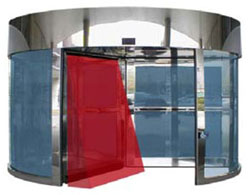 |
| Active Entry Point Sensor |
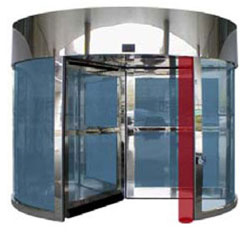 |
| Safety Edge Passive Sensor |
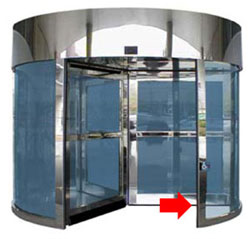 |
Manual revolving doors
The primary safety control of the manual revolving door is limiting the rotating speed using either a canopy or floor mounted speed device. The maximum allowable speed is 12 revolutions per minute.
Automatic revolving doors
Automatic revolving doors are furnished with a series of active and passive sensors. The sensors used are similar to that used for automatic swinging and sliding doors. Automatic revolving doors are activated by a canopy-mounted motion detector. Below is a brief description of the safety standard for automatic revolving doors:
For door wing safety, ANSI 156.27 Section 16.1 requires the sensors to detect a 28 inch high person in the rotating path a minimum of 10 inches in from the wing.
Automatic revolving doors also require entry point sensors to prevent entrapment at the intersection of the rotating wing and the approaching drum wall. The ANSI code calls for active entry point sensors, which shall detect the presence of a person or object when the door wing approaches the drum wall and stop the rotation.
In addition to the wall sensor, the drum edge farthest from the rotating wing is furnished with a contact safety edge. This edge, according to ANSI 156.27 section 17.1, is required to detect any obstruction of 10 pounds of force or greater and immediately stop the door rotation. This redundant protection ensures enhanced safety to pedestrians and peace of mind to business owners and overall traffic.
The bottom rail of the wing is typically furnished with a “toe guard” sensor. This sensor, according to ANSI 17.2, is designed to detect an obstruction no more than four inches from floor and with less than 10 pounds of pressure stopping the door rotation. It is intended to eliminate the possibility of a person’s heel being trapped under the wing.
Lastly, section 20.1 of the ANSI 156.27 code requires the furnishing of emergency buttons. These are designed to remove the power of an automatic door and must be located on both sides of door and stop door rotation until reset.
| Bottom Rail Passive Sensor |
Emergency Buttons |
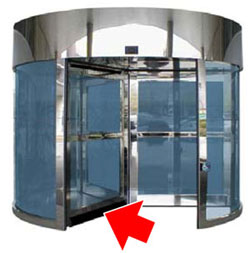 |
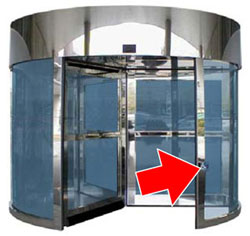 |
Choosing the Right Product
Critical to all designs is understanding building use and traffic patterns. With the above information you can choose from the following four possibilities:
- Manual Doors
- Automatic Doors
- Security Doors
- Exit Lane Turnstile Revolving Doors
Decide on your application needs and the process is relatively simple.
Manual Doors
Typical applications include banks, stores and restaurants, conference centers, and universities. A manual revolving door can accommodate large volumes of traffic in both directions. The choice between a 3-wing or 4-wing design depends on the application and the people using the entrance. A 3-wing design is preferable in a hotel application where larger compartment sizes are more critical. Guests at hotels typically have rolling or carried luggage and the larger compartment size would be preferred. Some grocery stores and restaurants use 3-wing doors to accommodate a parent with a child conveniently in the same compartment. The 4-wing design will give a slightly larger throughput as four people in each direction can pass through the door with each revolution. This design is recommended on higher volume applications where capacity is a concern such as conference centers or universities. Most manual doors are supplied in 78, 84, or 96 inch diameters.
Automatic Doors
With the need for hands free operation the typical applications include airports, hotels, casinos and hospitals. Automatic revolving doors can accommodate larger items like golf clubs and skis. They are also used in hospital applications as they can accommodate wheel chairs and the disabled. Automatic revolving doors are installed when you need to conveniently move larger volumes of people through a front entrance while maintaining high energy efficiency standards. Your choices in automatic revolving doors are 2-wing, 3-wing, and 4-wing and typically in 120 inch and larger diameters.
Two Wing
The 2-wing design offers the largest compartment size and the best airlock. In a hospital application, a 2-wing can accommodate gurneys. The reason the 2-wing design offers the largest compartment size is there is no center shaft or center core. The entire door including the ceiling rotates on a channel installed in the canopy. It offers the best airlock because in lieu of a center core there are two cores, one on each of the wings. These cores will completely close the throat opening to outside elements and are desirable in cold climates to prevent ice and snow from entering the throat opening during non-operating hours. When the wings completely close, the door is not always open always closed during a portion of the rotation. Because of the increased mechanical components necessary for this configuration (i.e., the rotating ceiling), the 2-wing is typically more costly than a comparable 3 or 4-wing alternative. The standard sizes for a 2-wing door range from 120 to 192 inches in diameter.
Three Wing
The 3-wing is the most common automatic revolving door design. The 3-wing door offers convenience and energy efficiency while maintaining lower installation cost. Since the 3-wing has a larger compartment size than the 4-wing, the 3-wing will move larger volumes of people through a 3-wing door. A 120 inch diameter revolving door in a 3-wing design will allow an unassisted wheel chair to pass through the door. An assisted wheel chair will require a 144 inch diameter. These designs are offered in ranges from 120 to 192 inches in diameter.
Four Wing
The 4-wing design is very seldom used in an automatic configuration. The compartment sizes are smaller than a 3 or 4-wing door system. The required wing sensors take up too much of the usable compartment size causing the door to stop or slow too frequently in a 2-way traffic situation. As a result, several manufacturers have discontinued offering this product especially since there are viable options such as the 2 and 3-wing designs.
Security Doors
There is a growing need to provide a more secure environment to facility users. Revolving doors have been used to provide a secure entrance for over 20 years. When a swing or slide door is equipped with a card reader and the necessary magnetic lock or electric strike, it is assumed to be a secure entrance. The deficiency is that once the door is open there is nothing to prevent multiple people from entering with an authorized person and thus a security breach. With a security revolving door, it turns one compartment at a time allowing only one authorized person to enter from the secure area eliminating employees from becoming part of the security team. Consider how many times a security entrance is breached by a simple request to hold the door open as a possible unauthorized individual enters the secure area. With a security revolving door, the employee does not have this option. Typically, a 4-wing design is ideal to provide 2-way security and has also been used in dormitory and office building applications as a standard revolving door during the day and a security door at night. A 2-way security revolving door will address both of these risk scenarios.
- Tailgating - Unauthorized entry attempt via separate compartment while an authorized person is entering or exiting
- Piggybacking - Unauthorized entry in the same compartment (forcible or collusion) with an authorized person
Airport Exit Lane Turnstiles
All airports have a secure and a non-secure side. Sometimes it is called airside and landside. The airport application is intended to keep the secure and non-secure sides separated. Entering airport security checkpoints has become routine for experienced travelers. Travelers are required to place their personal belongings on a conveyor belt for X-ray and pass through either X-ray or full body screen detection. After reaching a final destination, the traveler will exit through the secure area with either a manned station or airport revolving door. For the past 15-20 years, many airports have installed a physical barrier that takes travelers and airport employees from the secure area to the non-secure area. A one-way security revolving door has supplied the solution. Typically offered in a 3-wing design, this door allows travelers to leave the airport through a secure one-way only exit eliminating the need for a manned station allowing the guard to be deployed to make roving patrols.

- In the past 5-7 years airports have requested an additional level of security to prevent objects from being thrown/placed into the revolving door and “rotated” through to the secured side. Light curtains and volumetric sensor security prevent an object swept into the secure restricted area.

Typical Drum and Interface Connections
Revolving doors connect to the surrounding infrastructure in two possible ways:
- Center connected
- Throat connected
The selection is typically dictated by design. For example, an option to consider is whether it is desirable to have a portion of the revolving door on the building exterior. The fact that a revolving door is a free standing vestibule allows the unit to be located with flexibility. For example, locating the revolving as center-connected or even exterior to the building increases the lobby area. In the case when the door throat is connected, the revolving door stays inside the building. This design could reduce interference with pedestrian traffic using the sidewalks. Other applications have the door throat connected with the entire door being outside. This enhances merchandising space in a retail application or vestibule waiting space in a restaurant. For most applications the center-connected option is the norm.

Do Revolving Doors Really Save Money?
The answer to this question is a definitive YES. Empirical studies conducted by the Massachusetts Institute of Technology and ASHRAE have demonstrated that revolving doors are indeed a significant source of energy savings and hence a contributor toward a LEED sustainable design. The study concluded that the amount of energy to cool or warm a building is directly related to the amount of air exchanged to or from the building. Since revolving doors yield a better airlock than traditional swing or sliding doors, it follows that the energy required to keep the building at a preset temperature is lower than using a traditional entrance. Naturally, there are several factors involved in determining the saving, namely:
- Location of the entrance. Weather conditions are a key factor
- Number of hours the entrance is in operation (traffic)
- Desired temperature inside the facility
- Humidity and wind speed
- Building height
- Cost per kWH
Let’s take for example a building in the city of Toronto. The facility is 60 feet tall using a 3-wing 120 inch diameter revolving door instead of a vestibule entrance with two 168 inch sliding doors (72 inch net slide opening) results in the following savings:
(follow other assumption in simulation below):
- Cooling equipment savings of 1,267 tons
- Heating savings of 394,358 BTU/hr
- Reduced CO2 emissions of 258,250 lbs./yr.
- A payback using a revolving door of 20 months
Energy Savings Simulation Results
Hypothetical 60 Foot Tall Building in Toronto |
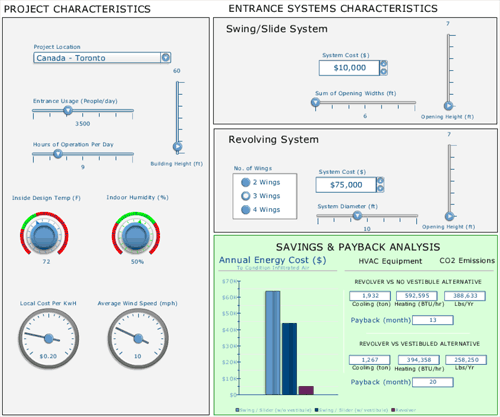 |
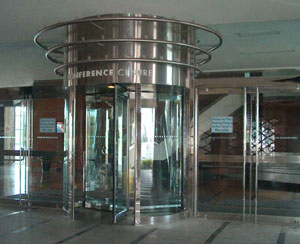 Combine Function with Aesthetics
Combine Function with Aesthetics
Now that it is clear what a revolving door can do for your entrance, it’s important to review another equally important aspect. Will this door give the intended look of my entrance and will it meet an architect’s aesthetic needs? Major airports, hotels, hospitals, and casinos have all chosen a revolving door for the enhanced grand appearance. While enjoying the energy efficient benefits previously discussed, revolving doors meet high architectural aesthetics and appeal. The material finish can be matched to adjacent construction and the wing/drum design can match important sight lines. Although revolving doors have been around for over 100 years, it’s the next 10 years that will see major increase in demand and acceptance as a preferred entrance solution.
Photos and images courtesy Horton Automatics
 |
Horton Automatics is a leading manufacturer of automatic entrance systems including sliding, swinging and revolving doors as well as platform screen doors, industrial doors and service windows. Horton is headquartered in Corpus Christi, Texas.
Horton Automatics
4242 Bladwin Boulevard
Corpus Christi, T 78405
800.531.3111
www.hortondoors.com |














 Combine Function with Aesthetics
Combine Function with Aesthetics







